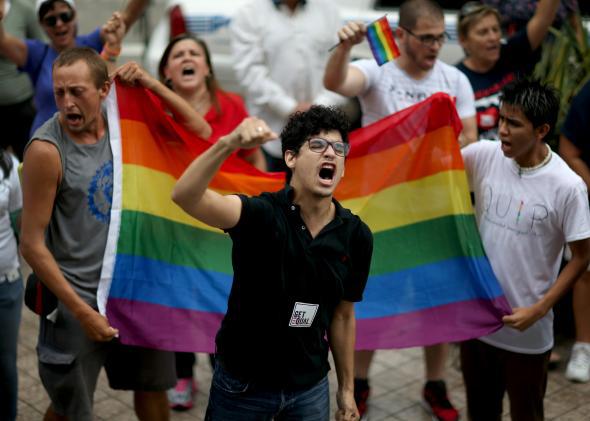Tuesday marked the 15th annual Celebrate Bisexuality Day. The holiday—also known as Bisexual Visibility Day—is part of Bisexual Awareness Week, taking place this year from September 21st through the 27th. Each day during the week has its own theme, ranging from Wednesday’s focus on bisexual representation in the media to Friday’s celebration of transgender individuals who happen to also be bisexual. As someone who is indeed both transgender and bisexual, I’ve been granted the distinct honor of being a member of the two most frequently overlooked segments of the grand LGBTQ initial-strand—though as it turns out, I’m nowhere near alone.
According to the 2011 National Transgender Discrimination Survey, only 23 percent of transgender individuals identified their sexual orientation as either straight or heterosexual. A quarter of all trans survey respondents identified themselves as bisexual, 23 percent said their orientation is best classified as gay, lesbian, or same-gender, 23 percent identify as queer, four percent as asexual, and two percent as something else.
Self-identified bisexuality in the general population is comparatively rare: The (much-criticized) National Health Interview Survey puts it at .7 percent, while a survey from UCLA’s Williams Institute found that 1.8 percent of respondents identified as bi. The point is the percentage of the general population identifying as something other than straight pales in comparison to the numbers found in transgender individuals, especially in terms of bisexual identification. It’s for this reason that one of the more popular conservative talking points—the idea that transgender women are simply gay men who medically and socially transition so that they can date men, and vice versa—makes little sense. If transgender women were “really gay men,” why is it that only 23 percent of us identify as straight women? The same goes for the idea that trans men are “actually just butch lesbians who want to date women.”
But conservatives aren’t the only ones who cling to misconceptions about the relationship between various LGBTQ identities. I’ve witnessed arguments from both inside and out of the LGBTQ ranks making the case that transgender individuals don’t really have a place in the overall LGBTQ movement. In many cases—such as a now-infamous Salon article from a prominent gay blogger in which he refers to bisexual individuals as “part time gays” and questions what he “[has] in common with a man who wants to cut off his penis, surgically construct a vagina, and become a woman”—the sense is that since gender identity and sexual orientation are completely separate matters, they should constitute completely separate movements. What some fail to realize is that even if trans individuals were purged from the larger LGBTQ movement, more than three-quarters of us would remain, albeit under a different letter.
This conversation, in which we must acknowledge the significant amount of overlap among LGBTQ individuals, is one on the wrong side of which I’ve found myself on a number of occasions. In nearly the mirror of that 2007 Salon post, I’ve spent time asking myself what I, as a bisexual, transgender woman, could possibly have in common with a gay, cisgender (non-trans) man. Unfortunately, the very basis of these types of questions encourages division rather than unity, and the levels of anger and frustration that often accompany them, complete with personal attacks, add nothing of value to a larger conversation about personal respect.
It took making these mistakes for me to understand that for all our differences—and there certainly are many—we’re people, and at very least, we share that in common. I don’t think the answer to a healthier, more inclusive LGBTQ community rests in efforts to assimilate into some sort of LGBTQ monolith, but rather, in working to understand that every one of us brings something unique to any conversation we enter.
So in the spirit of Bisexual Awareness Week, I plan to focus my efforts on celebrating our differences, atoning for my past mistakes, and doing my best to support others in an effort to foster a culture in which no one is judged on account of their sexuality or gender identity. As it stands, intra-LGBTQ arguments—many of which I have been a part of—are nothing short of toxic. Whether one is the face that comes to mind when someone thinks about LGBTQ individuals or a maroon on the island of misfit genders like me, there’s common ground to be had, and it begins with accepting one another.
